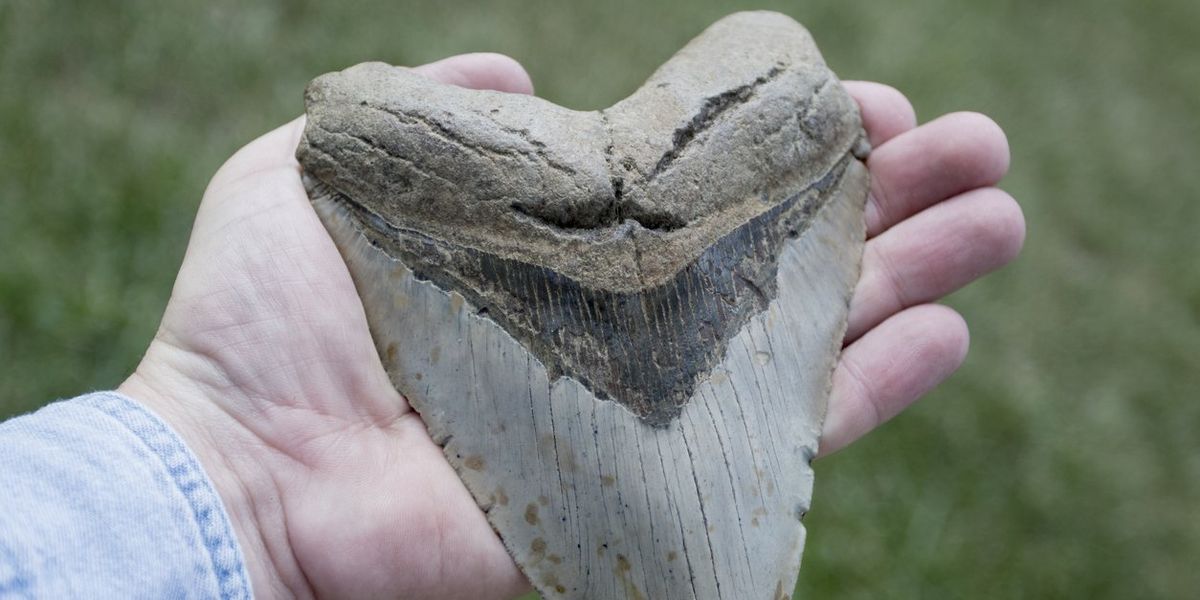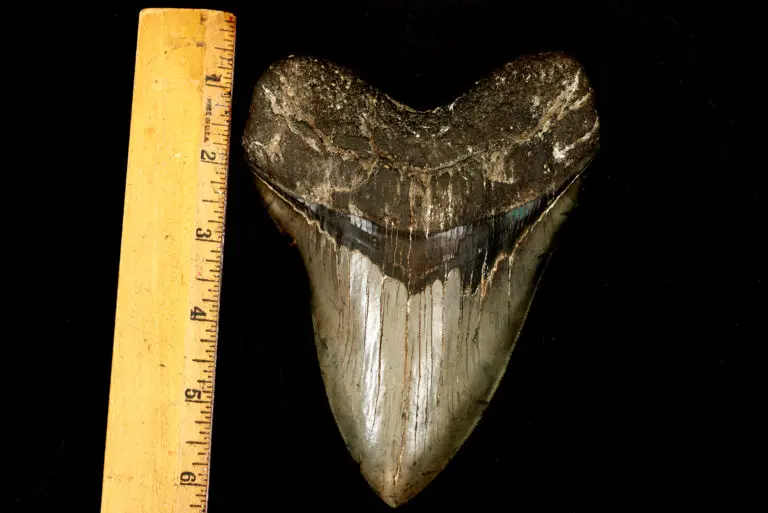Divers found some really big, old shark teeth in an underwater cave in Mexico. These teeth are from a megalodon, a giant shark that lived millions of years ago and was 50 feet long. This discovery helps us learn more about the megalodon and why it disappeared. To figure out why this huge shark isn’t around anymore, scientists are studying its teeth, which are the most common megalodon fossils we find.
Kay Nicte Vilchis Zapata, an experienced cave explorer and skilled photographer, found something amazing with her partner, Erick Sosa Rodriguez. They were on an underwater adventure and found a deep hole in the ground in the Cholul area, a place that used to be under water a long time ago. Inside the dark part of the cave, they found a bunch of old teeth fossils, 15 in total. What’s super cool is that they figured out 13 of these teeth actually came from three different kinds of sharks. The most exciting part? They found teeth from a huge, scary shark called the megalodon.

This important discovery has sparked a new interest in science, making everyone excited again about figuring out why the huge ancient shark, the megalodon, disappeared from Earth’s oceans. The fossilized teeth are super helpful, giving us important information about what the megalodon ate, where it lived, and its life’s story. By carefully studying these, scientists want to understand why the megalodon numbers went down and what happened to make it disappear, like it was part of a magic trick, from its place as the big boss of the oceans.
The Toothy Tale of the Megalodon
There’s a sunken cave filled with old shark teeth that gives us a special look into what the world’s ancient oceans were like. This cave is like a big storage chest of shark teeth fossils, showing us all different kinds of sharks that lived a long time ago, including the super impressive megalodon, the quick-swimming mackerel shark, and the weird-looking sawshark.
By carefully studying these old teeth, experts have figured out when the megalodon lived, which was about 5 million to 2.5 million years ago. Finding this out helps us solve some of the mysteries about the Earth’s past and learn more about the ancient sea animals that used to live in the ocean.
Dr. Sosa Rodriguez, an expert in studying caves, highlights how important these discoveries are. They fit perfectly with what we already know about the old plants and animals in this area from a time when it was under the sea. These new facts support the serious scientific work that went into this study.
Also, Dr. Salvador Estrada, a well-known expert in both human cultures and physics, has started a detailed study of the mysterious history of these ancient sharks. He’s using his knowledge across different fields to learn more about how these fascinating animals lived, where they stayed, and how they adjusted to their surroundings. By exploring these underwater caves further, we hope to discover more hidden information about the complicated history of life on our planet and its deep ties to the ocean.
Insights into the Megalodon’s Extinction
Recent research suggests that the megalodon may have experienced difficulties regulating its body temperature, which ultimately played a role in its extinction. Scientists have proposed that the ancient shark had a body temperature approximately 7 degrees Celsius warmer than the surrounding water.
An analysis of tooth enamel from the megalodon provides evidence for this hypothesis. The results published in the Proceedings of the National Academy of Sciences journal indicate that the energy required for the megalodon to maintain its elevated body temperature may have contributed to its demise. Lead researcher Robert Eagle, an atmospheric and oceanic sciences assistant professor, emphasizes the importance of studying the extinction of a highly successful predator like the megalodon to gain insights into the vulnerability of large marine predators in the face of ongoing climate change.
@rosethescientist If I never find another shark tooth, I will be just fine. @captknotsmith #charlestonsc #sharktooth #megalodon #shark #excited
Randy Flores, a doctoral student at UCLA and fellow of the Centre for Diverse Leadership in Science, adds that sustaining the energy level necessary to maintain the megalodon’s elevated body temperature might not have been sustainable in a changing marine ecosystem. The arrival of competitors such as the great white shark may have posed additional challenges for the megalodon, leading to its disappearance.
As we uncover more about this prehistoric giant of the sea, we gain a clearer understanding of the delicate balance within ancient marine ecosystems. The story of the megalodon offers important lessons about the potential vulnerability of current large marine predators facing the effects of climate change.
Exploring the Fossilized Secrets of Extinct Sea Creatures
Finding Megalodon teeth in a cave in Mexico shows just one cool part of a bigger story. It’s about the exciting world of sea animals that don’t exist anymore. Our Earth has a long history, and many amazing water animals lived and then disappeared. They left behind fossils that help us peek into what the world used to be. Here’s a list of some really interesting sea creatures that are now extinct. Divers, scientists studying fossils, and people who love this stuff have found these old remains. These discoveries help us learn more about the ocean’s mysterious history.
- Megalodon (Carcharocles megalodon): The colossal, prehistoric shark, known for its massive teeth, once ruled the oceans with jaws that could crush almost anything in its path.
- Ichthyosaur: These dolphin-like reptiles roamed the seas during the Mesozoic Era, resembling modern dolphins but with unique adaptations for life in the water.
- Plesiosaur: With long necks and paddle-like limbs, these marine reptiles swam during the Mesozoic Era, capturing prey in a manner akin to Nessie’s legend.
- Trilobites: While not exclusive to the sea, these ancient arthropods had numerous aquatic species. They are now found in fossil beds around the world.
- Ammonites: These squid-like creatures lived in spiral-shelled chambers and thrived in the oceans for over 300 million years before becoming extinct alongside the dinosaurs.
- Dunkleosteus: A massive, armored fish from the Devonian period, it is often referred to as one of the first apex predators in Earth’s oceans.
- Elasmosaurus: A long-necked, marine reptile closely related to plesiosaurs, Elasmosaurus hunted the ancient seas with its extended, flexible neck.
- Helicoprion: A bizarre, spiral-toothed shark-like fish from the Permian era that has intrigued scientists and divers alike.
- Steller’s Sea Cow: This large herbivorous marine mammal, related to dugongs and manatees, was hunted to extinction in the 18th century.
- Devonian Armored Fish: A group of extinct armored fish that existed during the Devonian period, displaying intricate armor plates and unique adaptations.
These extraordinary discoveries provide invaluable insights into the diverse and mysterious world of extinct sea creatures. By unearthing their remains, we gain a deeper appreciation of Earth’s natural history and the fascinating organisms that once populated its ancient oceans.
A Window into the Past, Insights for the Future
Finding big shark teeth in underwater caves in Mexico lets us explore the secrets of one of the most powerful sea animals. By studying these old teeth, experts are figuring out the life and death of these giant sharks. What we learn helps us understand the old underwater world and the dangers big sea animals face now, especially with the changing weather. By knowing about the past, we can make smarter choices to save the different kinds of life on our planet for later.
Sources:
Megalodon teeth in a flooded inland cave in Mexico
Teeth of world’s largest prehistoric shark

This Site Was Inspired By An Interest in Protecting the Environment:
We had the privilege and joy of learning from Dr. Charlie Stine who instilled a love for the natural world through incredible field trips with the Johns Hopkins Odyssey Certificate program in Environmental Studies. At the time, the program was endorsed by the Maryland Department of Natural Resources. Sadly, after Dr. Stine retired, the program was phased out. We hope that we honor his legacy by shining a bright light on environmental issues and sharing good news about the success of various conservation programs when possible.




